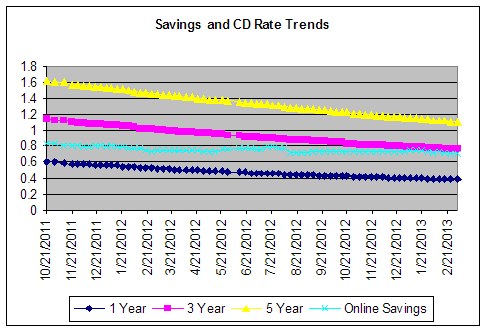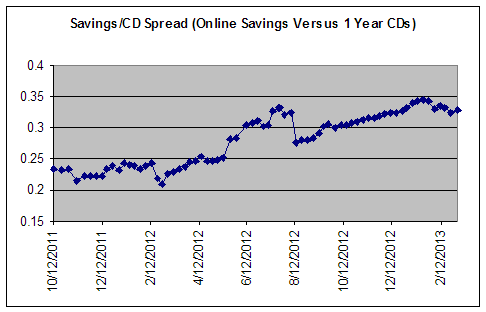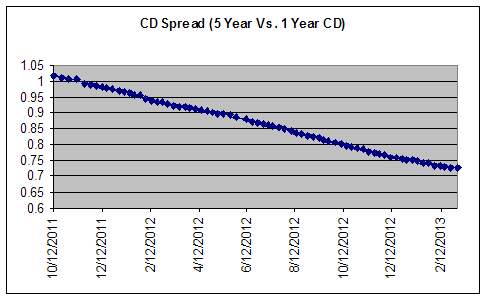Like the slow melt of snow outside my window, bank rates continue to melt off, continuing the decline begun in 2008. At that time, a top CD rate was 6%, today, savers would be lucky to get 2%. In the last week, average one-year CD Rates dipped from 0.385% to 0.383% APY. Three year average CD rates dropped from 0.762% to .757% APY. Five year average CDs dropped to from 1.113% to 1.107% APY. Online savings rate averages remained steady at 0.712% APY for the third week in a row. If the pace of decline continues, we could see 5 year CD rate averages dip below 1% APY sometime in August or September.
Even if the averages are all below 1%, the top rates are still significantly higher. BestCashCow data shows the top rates for some key terms are:
- Online Savings: AmTrust Direct retained the top spot at 1.05% APY.
- 1 Year CD: Five banks retain the top spot at 1.05% APY.
- 3 Year CD: CIT Bank at 1.44% APY
- 5 Year CD: CIT Bank at 1.85% APY and Barclays Bank Delaware at 1.85% APY.
- Rewards Checking: Hope Credit Union cut its rewards checking rate from 3.51% to 3.01% APY for balances up to $10,000. It is now tied with Money One Federal Credit Union for the best rewards checking rates. Both credit unions are open to members from across the country.
Local banks and credit unions often offer better rates (especially for CDs) than online banks so be sure to check them out.
The chart below shows the trend in average rates since October 2012.

The difference in the rate of decline between online savings and CD rates can be viewed on the chart below, which shows the spread between online savings account rates and 12 month CDs. The spread still remains very elevated although it has come down in recent weeks as several online banks have cut rates. On average, online savings account rates pay .329 percentage points more than 1 year CDs, up from .23 percentage points more at the beginning of last year but down from the spread's high of .344 percentage points in late January.

General rate environment
Three big events last week. First, the Dow Jones hit a record high. As of my last edit of this update (2:08 pm est on March 11) the Dow has hit a new record of 14,436. So what does this mean? A couple of things. First, the Fed's low interest rate policy that has buried savers has helped investors. Individuals and corporations are unwilling to keep all of their cash in the bank earning 1-2% and have deployed it into investments. This liquidity has helped boost the market. Five year CDs that investors parked their money in at the start of the financial crisis are now maturing, and many individuals will take pause to renew them at rates up to 1/3 lower. This money needs a home. That's not say the market will not go back down. It most likely will. But for now, it is providing a lift to many and a bit of optimism that could help keep things rolling.
Second, many key economic metrics are getting better, most importantly, unemployment. Last Friday, the government reported that employers added 236,000 jobs in February, helping to lower the unemployment rate to 7.7%. The unemployment rate is the magical number. The Fed has stated it will start to raise rates when this rate gets to 6.5%. But the yield curve has already started to move against the Fed. Long term rates are rising in anticipation of faster growth and inflation. At the beginning of the year, the yield on 10 year treasuries was 1.86% while on Friday it closed at 2.06%.
The third piece of data is the improving Texas Ratio that BestCashCow calculated for the banking and credit union industry and the near record profits for this sector. As I wrote last week, the Texas Ratio is a metric BestCashCow uses to assess the health of banking and credit union industry and in fell for the 12th straight quarter last December. For banks, the average Texas Ratio is now 17.60% while for credit unions it is 7.39%. For individual institutions, a Texas Ratio over 100% is a cause for concern about its safety and soundness. For the full year, the banking industry earnings totaled $141.3 billion — a 19.3 percent improvement over 2011 and the second-highest ever reported by the industry after the $145.2 billion earned in 2006. Credit Unions' earnings hit an all-time high.
Taken together, the economy is starting to bubble and even the increase in the payroll tax at the beginning of 2013 doesn't look like it will derail the expansion. Government cutbacks combined with local, state, and Federal tax increases could, though.
My outlook: Savings rates will continue to drift lower for the next 9-15 months before beginning to move higher. How high and how fast they move will depend on the level of local, state, and federal taxes and cuts, ; the continuation of a recent economic uptick; technological advances; and the ability of Europe to put its woes behind it and resolve its fiscal problems.
Savings Accounts or CDs?
The data continues to show that opening a savings account is a better bet than a 1-3 year term CD and I expect this to hold through 2013. Online savings accounts have held the line over the past year while CD rates continue to fall. As the chart shows, the premium for opening a longer-term CD has eroded significantly and continuously over the past year. While the premium for opening a 5 year CD over a 1 year CD was 1 percentage point in October 2011, it now stands at .728 percentage points.
So for now, here are my recommendations on which deposit accounts to open::
For money you want to keep liquid, go with online savings accounts. They offer better rates than 1-3 year CDs and athough several banks have dropped rates in the past week, they have still offered decent rate stability over the past year.
If you want to take advantage of the higher rates on longer-term CDs, look to open them at local community banks. BestCashCow research has shown that community banks and credit unions offer the most competitive rates on longer-maturity CDs. Otherwise, you'd be better off keeping your money liquid in an online savings account.
I believe this is the best and easiest strategy for keeping your cash liquid and maximizing your savings over the next year.

Make the best of a tough savings situation in 2013
Yields may be low in 2013 but a savvy saver can boost the return with no increase in rate by rate shopping. By shopping around, a saver can earn an extra half to full percentage point. On $100,000, that's $1,000 in extra cash per year. Remember, even in today's environment, there is competition for your cash.












Comments
Sol
March 15, 2013
Housing kicking into gear. Economists expect big gains in housing prices next year.
http://www.bloomberg.com/news/2013-03-15/jpmorgan-sees-home-prices-up-14-as-bofa-touts-party.html
Is this review helpful? Yes:0 / No: 0
Sol
March 15, 2013
Inflation increased 0.7 percent in February on a seasonally adjusted basis, the U.S. Bureau of Labor Statistics reported today. Over the last 12 months, the all items index increased 2.0 percent before seasonal adjustment.
Most of the increase came from rising gasoline prices. Core CPI, which strips out food and energy, rose .2 percentage points, in line with expectations.
Bottom line: No inflation pressure. The Fed still does not need to worry about inflation.
Is this review helpful? Yes:0 / No: 0
Add your Comment
or use your Google account
or use your BestCashCow account